Begin With the End In Mind: The “What,” “Why,” and “How” of This Powerful Philosophy
When’s the last time you stopped to think about what you really want? Not what you need, but what you really want to achieve with your life.
Unfortunately, many people never seriously ask themselves this question. As a result, they never end up accomplishing their dreams. We don’t want that to happen to you too so today, we’re going to shed some light on this topic and discuss how to begin with the end in mind. In this article, you’ll learn what this philosophy is and why it’s so important.
We’ll also teach you a simple, five-step process you can use to begin with the end in mind today.

What it Means to Begin With the End In Mind
According to Dr. Stephen R. Covey , all things are created twice — first in the mind, and then in the real world. Physical creations follow mental ones, just like homes are built according to blueprints. To make your deepest desires a reality, you first need to see and understand what those desires are. So, in short, to begin with the end in mind is to visualize your life, career, or a specific project the way that you want it to end up being before you actually begin pursuing it. When you make this conscious effort, you take much greater control over your life and circumstances.
There are, in our opinion, three main reasons why this “begin with the end in mind” philosophy is so important. They are clarity, efficiency, and purpose. Let’s take a closer look at each one.
When you understand where you want to end up, you’ll gain tremendous clarity in many areas of your life. For example, if you realize that your greatest career goal is to become an entrepreneur and own your own business, the steps to achieving this end become clear.
First, you have to come up with a viable business idea. Then you need to create your product, get customers, hire employees , find investors, etc.
Obviously, the steps you take will be unique to your vision, but the general aspects of owning a business remain. When you begin with the end in mind, you’ll also gain clarity as to what NOT to do and pursue. If your goal is to live in a beach house in Hawaii, you might decline a job offer from a company in Boston.
Then again you might not if the job pays well and will provide you with the funds to purchase your beach house sooner. Either way, you’ll know what your next move should be because you know where you’re trying to get to.
When you begin with the end in mind you gain clarity, which will naturally help you become more efficient. You’ll be able to plan and strategize for the best route to your goals. Let’s say that you want to become a project manager at your company within the next two years. That’s your goal. You can now plan out the most efficient way to achieve it. Instead of chasing erroneous objectives, you’ll focus on just the steps you need to take to become a project manager.
Finally, when you begin with the end in mind, you gain purpose.
You’ll be chasing goals that are actually meaningful to you, building a career you can be proud of, and living the kind of life you want.
Many people find that they lack fulfillment because they’re chasing other people’s goals without realizing it. Not everybody wants to be a rich and famous millionaire, or be the CEO of a company, or have a vacation home in Miami — at least not enough to put in the work required. Many people would rather live a quiet life with the people they love.
There’s nothing wrong with that! The key is focusing on what you really want and working to achieve it. That’s how you gain purpose and fulfillment.
How to Begin With the End In Mind
So far we’ve covered the “what” and “why” in regard to beginning with the end in mind. Now, let’s tackle the “how”. There are five steps:
1. Dream Big (Or Small)
First, you need to decide where you really want to go. This can be done on a grand scale for your entire life, or on a much smaller level for any project you’re currently working on. Either way, identify what it is you hope to achieve. Up for a little reader participation? The following is an exercise we first learned about from Ryan Carson , founder and CEO of Treehouse.
It’s a great way to understand what you want to accomplish. Note: this exercise allows you to clearly examine your entire life and what you want to achieve during it. But it can easily be adapted for small, everyday goals as well.
A Visualization Exercise
Imagine yourself in your home. It’s the morning time, you’ve just woken up, and you’re preparing to go to an event later in the day.
You’re not exactly sure what the event is, but you know it’s important. Now, imagine yourself getting ready for this event, the clothes you’ll wear, the way you’ll style your hair.
Once you’re ready, picture yourself leaving your house for the venue. What’s the weather like outside, what are the neighbors doing, how’s traffic?
You follow your GPS’ instructions and after a few minutes, you arrive at a building. As you walk through the front doors and into a lobby area, you’re greeted by your loved ones. All the people in this world that mean the most to you. They’re all smiling. Finally, you walk through another set of doors and into a giant auditorium. You find more of your loved ones here, your family, friends, business associates. Your favorite teacher from high school or your hairdresser perhaps. Every person who’s ever mattered and played a role in your life is there.
Imagine what this place looks like and how you might feel. Then it hits you; you’re at your own funeral and every person in the auditorium is there to celebrate and reflect upon your life. What would they say? More importantly, what would you want them to say?
This may seem like a long, drawn-out example, but it’s an important exercise. You’ll immediately realize what and who really matters to you. You can then use this information to your advantage.
2. Be Honest
Next, you need to assess your current situation. Where are you right now in regard to where you’re trying to go? If you weren’t clear on your goals before completing the first step, you may find that you need to make serious adjustments to get yourself on the right path. That’s okay!
It’s better that you found out now than next week, month, or year. Now you can make the necessary changes and start chasing your true objectives sooner.
It’s really important that you’re brutally honest with yourself during this step. The more clearly you see your current situation, the better prepared you’ll be to remove yourself from it and chase your dreams.
3. Design a Path
When you know exactly where you stand and have a clear vision of where you want to end up, you’re ready to start designing a path between the two. The objective is to draw as straight of a line between you and your goals as possible. We recommend working backward from what you hope to achieve.
After all, we’re trying to begin with the end in mind, remember?
So first picture your endpoint. Now imagine the point right before it. Keep doing this until you’ve reached your current situation. Let’s use a personal goal like learning to play the piano as an example. You’ve decided that you want to become a piano player and be able to play Fur Elise by Beethoven on the ivories. (If the name of this composition isn’t familiar to you, look it up. You’ve heard it before.)
Working backward from this goal, you realize that you must learn a number of simpler pieces before you’ll be ready to play Fur Elise. In order to learn these simpler pieces, you must practice. But how will you know what to practice (and if you’re practicing proper technique) without a teacher?
Your teacher will require you to have your own piano or keyboard, which you don’t currently have. To save up enough money to by one, you commit to taking extra shifts at the diner where you work.
A path to your goal of learning to play piano might look something like this then:
- Take extra shifts at the diner to save up money for a piano.
- Buy a piano and hire a piano teacher.
- Practice the songs she assigns you, starting with easy pieces such as Ode to Joy.
- Keep practicing and begin to learn more intermediate pieces like Billy Joel’s Piano Man.
- Finally, ask your teacher to teach you Fur Elise by Beethoven.
- Practice the piece until you’ve mastered it.
- Tell all your friends that you know how to play the piano.
See how that works?
4. Put Pen to Paper
After completing steps one, two, and three, it’s time to put pen to paper and craft your mission statement .
A mission statement is just a sentence or two that defines your purpose, why that purpose matters to you, and how you plan to pursue it. Again, this could be a personal mission statement for your life, a corporate statement for your company, or a project statement for the task you’re currently working on.
And the best part is, you’ve already done most of the hard work for this step!
You’ve already defined your purpose. It’s what you’re trying to achieve. The goal you’ve set for yourself.
You’ve also already identified why that goal is important to you. Both of these things were accomplished in the “Dream Big (Or Small)” step. You’ve even determined how you plan to achieve your goal. That’s what we covered in step three when you designed your path. Now all you need to do is assimilate this information into a concise mission statement. Here are a few examples from people you’re undoubtedly familiar with. Feel free to use them as templates for your own mission statement.
- “To be a teacher. And to be known for inspiring my students to be more than they thought they could be.” — Oprah Winfrey
- “To use my gifts of intelligence, charisma, and serial optimism to cultivate the self-worth and net-worth of women around the world.” — Amanda Steinberg, founder of DailyWorth
- “To create content that educates, informs and inspires.” — Public Broadcasting System (PBS)
5. Fully Commit
The last step is commitment. You can identify both your goals and your current status in achieving them.
Then you can concoct the greatest plan to get you from where you are to where you want to be in the least time possible. You can even take time to craft an amazing mission statement that sums up your entire purpose and plan in one or two concise sentences. But you’ll only get where you want to go if you fully commit and work hard — even when it seems hopeless or you don’t feel like it. This is where the rubber really meets the road. We’ll be honest, it will probably get difficult from time to time. But if you stick with it, you’ll find joy, purpose, and fulfillment.
And you’ll be able to look back afterward and be proud of your accomplishments. When the going gets especially tough, remember your “why” — the reason you wanted to accomplish this goal in the first place. It will give you perspective and motivate you to keep moving forward no matter what stands in your way. You may also want to find an accountability partner to help you beat procrastination and keep you on track.
The “End In Mind” Philosophy Illustrated
Before we wrap up this article up, we want to give you an example of what all five of these steps look like in a real-life scenario.
Anna is a freelance web designer from Seattle, WA. She’s been in business for three years and makes a solid living doing what she loves. But she also feels like something’s missing. She’s just read this very blog post and decides that she needs to evaluate her life and career and begin with the end in mind.
After completing the visualization exercise mentioned earlier, Anna discovers that, while she loves her job, she misses the camaraderie of working with other humans on a regular basis. She decides that she doesn’t want to remain a solo freelancer forever.
Eventually, she wants to own and operate her own web design studio. But taking a look at her current situation, Anna realizes that she has a lot of work to do before she can accomplish this goal. First off, she’s not making nearly enough money to rent office space, hire employees, etc.
She also decides she needs to learn more about business and leadership before she’s qualified to be an entrepreneur. Ann is far from daunted, though, and immediately gets to work planning a path to her dreams. She needs to get more clients, the kind that will be willing to pay higher fees.
She also decides to frequent local designer meetups and conferences in order to meet designers to hire. Lastly, she signs up for night classes at the local college to learn business and leadership principles. With these first three steps completed, Anna goes to work on her mission statement. She ends up with: “To start and run a boutique web design agency that’s well-respected, operates with integrity, and provides a comfortable living for each of the talented designers I’ll employ.”
Finally, Anna commits to her dream by asking her best friend from college to be her accountability partner.
In Conclusion
When you begin with the end in mind, you set yourself up for success. There’s no better way to identify what you actually want, why it’s important to you, and how to get it. To implement this philosophy in your life, simply follow the five steps outlined in this article:
- Dream Big (Or Small): What do you really want to achieve?
- Be Honest: Where are you now in regard to your goals?
- Design a Path: What’s the most direct route from where you are to where you want to be?
- Put Pen to Paper: Craft a mission statement that encompasses your goals, why they’re important to you, and how you’ll accomplish them.
- Fully Commit: Decide right now that you’ll do what it takes to make your dreams a reality.
Begin with the end in mind and you’ll find much more joy, purpose, and fulfillment in whatever you do. Good luck!
Join 30,000+ subscribers getting the best tips on productivity, work management, hiring and more!
We promise we won't spam you and you can unsubscribe anytime.
You might also like...
Related to Project Management
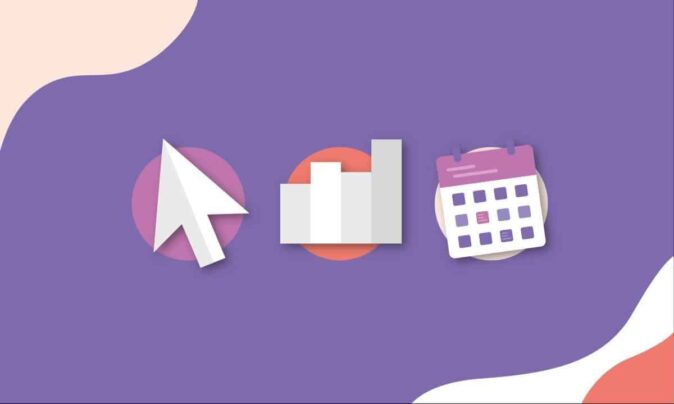
10 Simple Project Management Software (With No Learning Curve)
Project Cost Management: The Ultimate Guide
What Are The Advantages Of Using A Gantt Chart In Project Management?
Take a peek at our most popular categories:
- Product overview
- All features
- App integrations
CAPABILITIES
- project icon Project management
- Project views
- Custom fields
- Status updates
- goal icon Goals and reporting
- Reporting dashboards
- workflow icon Workflows and automation
- portfolio icon Resource management
- Time tracking
- my-task icon Admin and security
- Admin console
- asana-intelligence icon Asana Intelligence
- list icon Personal
- premium icon Starter
- briefcase icon Advanced
- Goal management
- Organizational planning
- Campaign management
- Creative production
- Marketing strategic planning
- Request tracking
- Resource planning
- Project intake
- View all uses arrow-right icon
- Project plans
- Team goals & objectives
- Team continuity
- Meeting agenda
- View all templates arrow-right icon
- Work management resources Discover best practices, watch webinars, get insights
- What's new Learn about the latest and greatest from Asana
- Customer stories See how the world's best organizations drive work innovation with Asana
- Help Center Get lots of tips, tricks, and advice to get the most from Asana
- Asana Academy Sign up for interactive courses and webinars to learn Asana
- Developers Learn more about building apps on the Asana platform
- Community programs Connect with and learn from Asana customers around the world
- Events Find out about upcoming events near you
- Partners Learn more about our partner programs
- Support Need help? Contact the Asana support team
- Asana for nonprofits Get more information on our nonprofit discount program, and apply.
Featured Reads

- Project planning |
- Begin with the end in mind to maximize ...
Begin with the end in mind to maximize your potential
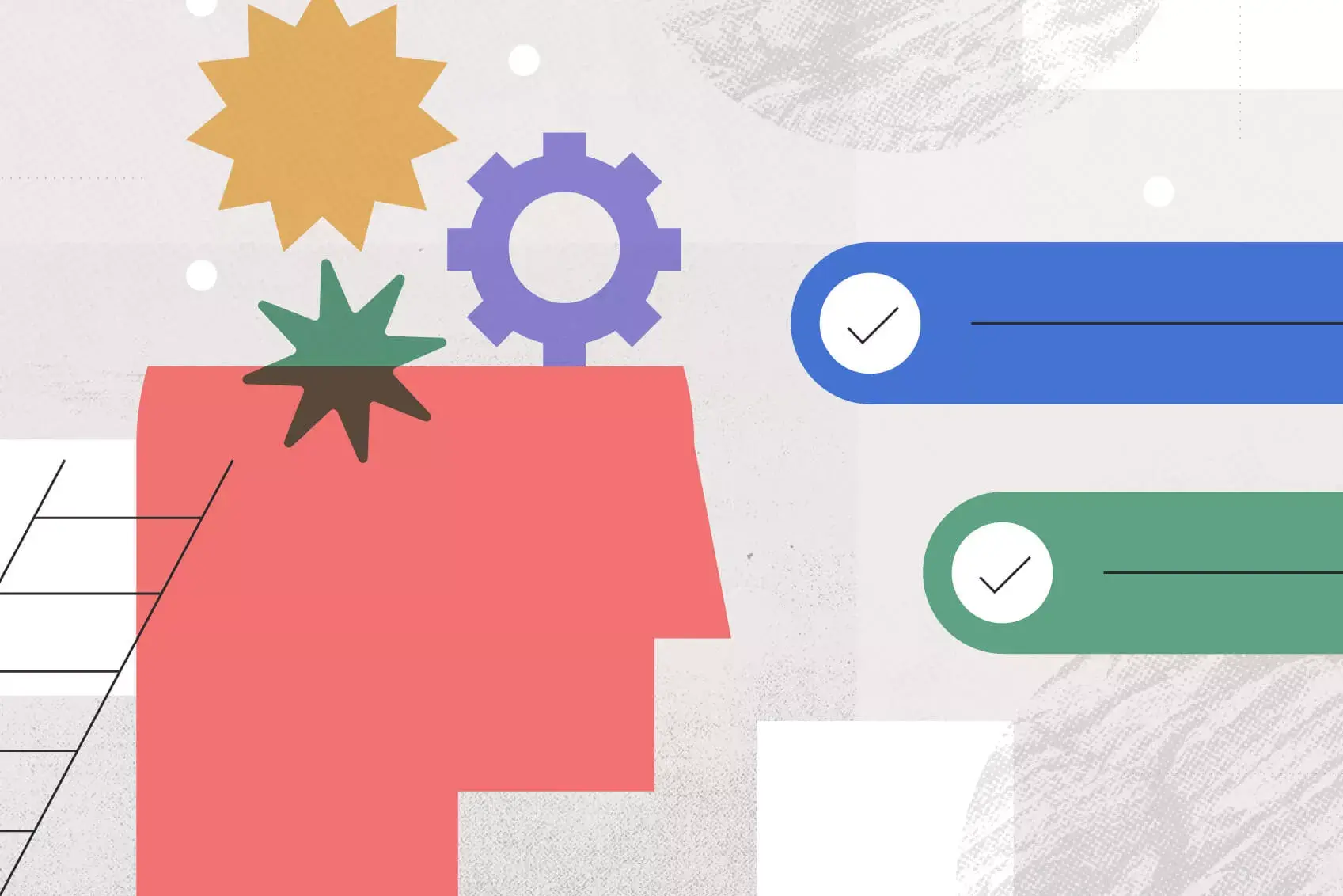
“Begin with the end in mind” is the second of the seven habits of highly effective people Dr. Stephen R. Covey defines in his bestselling book. The habit is based on the principle that all things are created twice: once in your mind and once in the physical world. In this article, you'll learn how to begin with the end in mind by writing a personal mission statement.
How do you get to where you want to go? Whether it’s your company’s goals or your personal ones, defining them and creating a game plan with action steps can help keep you motivated and make your journey feel more purposeful.
Covey believed that “your most important work is always ahead of you, never behind you.” So let’s dive into how you can shift your mindset and work smarter toward your goals by incorporating this second habit into your lifestyle. Then, learn how effective leaders also share this concept with their teams and inspire them to prioritize their personal development.
Decision-making tools for agile businesses
In this ebook, learn how to equip employees to make better decisions—so your business can pivot, adapt, and tackle challenges more effectively than your competition.

How to begin with the end in mind
How does one begin with the end in mind? Stephen Covey based this habit on the principle that all things are created twice: once in your mind and once in the real world. According to Covey, envisioning and creating your goal mentally first allows you to determine whether or not the second, physical creation of the goal will be possible.
![begin with the end in mind presentation [inline illustration] How to begin with the end in mind (infographic)](https://assets.asana.biz/transform/2ba09613-4db5-412a-bcf3-18e60cddb2a0/inline-project-planning-begin-with-an-end-in-mind-1-2x?io=transform:fill,width:2560&format=webp)
There are a few different ways you can approach beginning with the end in mind—one of the best and most efficient ways to get started is to create a mission statement for yourself.
Write a personal mission statement
Unlike a mission statement for your company, you can apply your personal mission statement to pretty much any aspect of your life. This exercise can help you visualize and define your personal, fitness, family, or career goals.

People are working harder than ever, but because they lack clarity and vision, they aren’t getting very far. They, in essence, are pushing a rope with all of their might.”
Creating a personal mission statement takes time and energy but allows you to work strategically toward your goals. Here are a few things you can ask yourself:
When do you perform your best or worst?
What makes you passionate about your personal life or career?
What are your natural talents and gifts?
If you had unlimited resources and failure was out of the question, what would you do with your life ?
What is your life’s journey ? Define what you’re doing, who you’re doing it for, the reason behind your actions, and the results you’re aiming for.
Picture yourself at the end of your career. What would you like people to say about you as a person ?
What contribution would you consider the most important in your future and who are the people it should touch?
Is there anything you would like to change about yourself ?
Think about up to three people who have influenced your life thus far. Write down their names and the qualities that you admire about them.
How can you achieve a sense of balance in your physical, spiritual, mental, social, and emotional life?
Creating a personal mission statement puts you in the driver’s seat of your own life. You can also write a family mission statement or a team mission statement to include others in your goal-setting exercise.
Let’s have a look at what someone’s personal mission statement could look like.
Meet Kat Mooney. Kat performs best when she feels seen and valued by her colleagues, friends, and family. Whenever she feels isolated or disconnected, her performance drops. She has a passion for helping and supporting others and has amazing people skills.
When she’s being honest with herself, her current role as a remote HR manager at a large corporation isn’t what she’d chosen for herself—it’s more of a means to an end. If she could choose any job, she’d probably become a life coach or work for a non-profit.
At only 27 years old, Kat hasn’t really defined what her life’s journey should entail. She’s happily single and doesn’t feel rushed into getting married or having a family. For now, she wants to focus on what’s best for her and how she can contribute to making this world a better place. When she pictures the end of her career, she’d love for people to see her for who she really is—an energetic, kind, and giving person.
Something she’s not happy with is how stuck she feels in her current role without doing anything about it. Kat is sure that by cutting these ties and finding a position that fits her personality and goals, she can achieve a sense of balance and happiness in her life.
After creating her personal mission statement following the questions above, Kat may realize that taking the risk and changing her career to become a life coach is going to make her happy. Or maybe she finds a company where she can work in the office again to make personal connections and feel less isolated. Another route she could take would be to shift gears and switch from HR to the Diversity & Inclusion department of a company so she can lean into her passion for building strong communities.
Use SMART goals
A personal mission statement is a great way to begin with the end in mind, but it can be difficult to grasp what that actually means. This is where SMART goals come in handy.
The act of attempting new things helps us grow. Whether or not we achieve a specific goal, it’s the courage to try and succeed—or fail forward—that builds resilience, character, and the energy needed to propel us forward in our careers.”
SMART goals can help you plan your career or set realistic expectations for your team’s performance. SMART goals are specific, measurable, achievable, realistic, and time-bound. Once your personal mission statement is done, you can use it as the foundation for setting SMART goals.
In Kat’s example, one of her goals may be to start looking for a new job. This is a very vague goal which she can turn into a more precise one using the SMART framework:
“In April (time-bound), I will spend four hours every week (measurable and achievable) to send out applications for Diversity & Inclusion roles at companies in a one hour radius from my house (specific). My goal is to find a new position by the end of June that meets or exceeds my current salary (realistic).”
Whether you’re trying to set long-term or short-term goals , making them SMART will not only help you break your goals down into more manageable pieces; this will also ensure that they’re trackable. This step will help you transform your personal mission statement into actionable goals.
Write a retrospective about your life
If you struggle to come up with a mission statement for your life, try to turn things around and literally begin at the end with this little exercise. Choose a time in the future (five or 10 years from now) and picture that this time is now. Write a diary entry or a letter to your current self from that point of view, sharing your accomplishments, struggles, and hopes.
Writing this retrospective from the future can take some of the pressure off of you since you’re writing from the perspective of having already experienced the next few years. This exercise can help you get a clearer picture of your priorities in life, career goals, and wishes for the future.
A broken down version of Kat Mooney’s retrospective may sound a little like this:
“The year is 2030, I am the Director of Diversity & Inclusion at my dream company. Since I quit my HR role a few years ago and started at this company, my mental health has drastically improved. I no longer feel isolated, I feel a sense of control over my work, and I know that my work is positively impacting the lives around me which makes me very happy.”
This exercise is also an enlightening tool to share with your team when they’re struggling to define their goals or feel stuck in their current situation. While they don’t have to share the results of their retrospective with you, you can offer to support them in reaching their newly discovered milestones.
The 7 habits of highly effective people
![begin with the end in mind presentation [inline illustration] The 7 habits of highly effective people (infographic)](https://assets.asana.biz/transform/e5c0ad52-2927-4121-a6ef-f30326c61770/inline-project-planning-begin-with-an-end-in-mind-2-2x?io=transform:fill,width:2560&format=webp)
Beginning with the end in mind is one of the seven habits that Dr. Stephen R. Covey established in his book on highly effective people. He viewed habits as consistent, unconscious patterns that affect people’s effectiveness. According to Covey, habits are the intersection of skill, knowledge, and desire:
Knowledge is the “what to do and why”
Skill defines how we do things
Desire is the motivation behind our actions
If you’re fascinated by the concept of beginning with the end in mind, you’re probably wondering what the other six habits entail. Let’s take a quick look at the full list he created:
Habit 1: Be proactive —Be aware of your surroundings so you can anticipate when and how you have to take responsibility for your life.
Habit 2: Begin with the end in mind —Create a goal for yourself and work toward it.
Habit 3: Put first things first —Focus on the things that are important and don’t let random tasks get in the way of your productivity.
Habit 4: Think win-win —Make sure everyone you work with is treated fairly and all interactions provide a mutual benefit for the parties involved. This will help you create strong and reliable relationships that you can count on when you need support.
Habit 5: Seek first to understand, then be understood — Actively listen when someone comes to you with a problem. Avoid jumping to conclusions or trying to provide solutions before you know the full picture.
Habit 6: Synergize —Remember the importance of teamwork and foster a culture of collaboration .
Habit 7: Sharpen the saw —Rather than overworking yourself, Covey suggests creating a sustainable lifestyle that allows you to balance your work and time outside of work.
The main takeaway from these habits is that success doesn’t just come to you, it’s the result of hard work, teamwork, and smart planning.
Set strategic but flexible goals
Setting strategic goals can be challenging. After all, real life doesn’t always go as planned. —outside factors, lack of motivation , or miscommunication can shift your timeline or change the goals you’ve been working toward.
A digital goal-setting software allows your team to create agile company goals, refine them when necessary, and visualize each teammate’s individual contribution so everyone feels inspired to do their best work.
Related resources

How to use a feasibility study in project management

How to track utilization rate and drive team profitability

How to accomplish big things with long-term goals

Smooth product launches are simpler than you think
- Begin With the End in Mind
- Presentation Courses
Stephen Covey offers this advice in his book, The 7 Habits of Highly Effective People". The book is a guide to developing your personal leadership. "Begin with the end in mind" is the first habit and thus likely the most important. You can apply this first habit from Stephen Covey's leadership prinpcles to your presentation in three ways.
1. Develop your presentation with the end in mind. The first thing that you should do is to write a short simple statement that clarifies your purpose. Then you will develop your presentation faster and it will be better focused. Invest the time and thought to clairify the purpose and desired outcomes of your presentation. Too many people speak just because they were asked or told to speak. Thus, their presentation becomes a chore - to them and the audience.
2. Give your audience a roadmap. Tell your audience, early in your presentation, where you are going. Don't make them guess - because you might lose, confuse or annoy them. Your audiences needs to know why they should listen to you. They have plenty of others things on their mind and they will not give you the attention you want unless you convince them that you know where you are going.
For example: "By the end of this presentation you will have a better understanding and appreciation of the safety measures that we have put into place for you."
3. Deliver your presentation with the end in mind. The only reason you are speaking is to achieve your goal. Stay focused on your goal during your presentation so you don't get thrown by diversions or drawn off on tangents. And if you reach your goal early - they agreed to the deal - then finish your presentation early and sign the contract.
When you know where you are going you will avoid the tangents and diversions that often destroy presentations. When you begin with the end in mind you will waste less time and be more effective. Use the advice of Stephen Covey - Begin with the end in mind.
� George Torok is the Speech Coach for Executives. He coaches executives and trains sales professionals to close million dollar deals. Get your free Power Presentation Tips by registering at http://www.SpeechCoachforExecutives.com Arrange a keynote speech or training program by calling George Torok at 905-335-1997 or visit http://www.Torok.com
Please note our site uses cookies to improve the user experience and to track site usage. By using our website, you agree to our privacy policy
- Hidden Close Button (Mobile)
- Why FranklinCovey

Develop Your Leaders
Develop leaders who can build highly effective teams, navigate change, and deliver exceptional business results.

Engage Your People
Build the power skills of personal and interpersonal effectiveness to unlock the potential in your organization.

Build a Winning Culture
Cultivate a high-trust, inclusive culture where great ideas thrive and people can do their very best work.

Achieve Breakthrough Results
Turn sporadic performance into a system of consistent, predictable results for your business.
- The 4 Disciplines of Execution®
- The 4 Essential Roles of Leadership®
- The 5 Choices to Extraordinary Productivity®
- The 6 Critical Practices for Leading a Team™
- The 7 Habits for Managers®
- The 7 Habits® Leader Implementation
- The 7 Habits of Highly Effective People®
- The 7 Habits of Highly Effective People® Foundations
- Change: How to Turn Uncertainty Into Opportunity™
- Fundamental Beliefs of Trust & Inspire Leaders
- Helping Clients Succeed®: Closing the Sale
- Helping Clients Succeed®: Filling Your Pipeline
- Helping Clients Succeed®: Qualifying Opportunities
- Inclusive Leadership: Practical Ways to Cultivate Inclusion & Build a Better Team™
- Leading at the Speed of Trust®
- Leading Customer Loyalty®
- Microlearning
- Multipliers®: How the Best Leaders Ignite Everyone’s Intelligence
- Navigating Difficult Conversations: Turn Tension Into Progress™
- Presentation Advantage
- Project Management for the Unofficial Project Manager™
- Working at the Speed of Trust®
- Unconscious Bias: Understanding Bias to Unleash Potential™

Live Online Events

Public Workshops
- Resource Center
- Mission Statement Builder
- Our Mission, Vision, and Values
- Our Commitment to Diversity
- Our Careers

Global Locations
Habit 2: begin with the end in mind ®, the habit of personal vision.
Habit 2: Begin With the End in Mind is based on imagination—the ability to envision in your mind what you cannot at present see with your eyes. It is based on the principle that all things are created twice. There is a mental (first) creation, and a physical (second) creation. The physical creation follows the mental, just as a building follows a blueprint.
If you don’t make a conscious effort to visualize who you are and what you want in life, then you empower other people and circumstances to shape you and your life by default. It’s about connecting again with your uniqueness and then defining the personal, moral, and ethical guidelines within which you can most happily express and fulfill yourself.
One of the best ways to incorporate Habit 2 into your life is to develop a Personal Mission Statement . It focuses on what you want to be and do. It is your plan for success. It reaffirms who you are, puts your goals in focus, and moves your ideas into the real world. Your mission statement makes you the leader of your own life. You create your destiny and secure the future you envision.
How Effective Leaders Get Results: 7 Ways to be More Proactive
Learn how taking initiative in small, specific ways can help you reach your goals — for your team, your career, and your life.
Join us for a complimentary live online event on leadership
Learn how the powerful lessons of personal change from The 7 Habits can help transform the behaviors of your workforce.

Understand the end result
Begin With the End in Mind means to begin each day, task, or project with a clear vision of your desired direction and destination, and then continue by flexing your proactive muscles to make things happen.
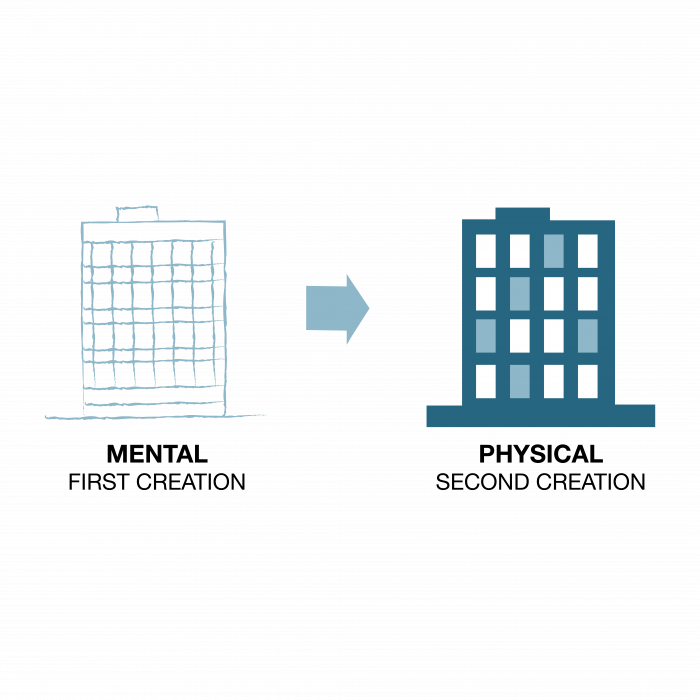
People are working harder than ever, but because they lack clarity and vision, they aren’t getting very far. They, in essence, are pushing a rope with all of their might.
— Dr. Stephen R. Covey
80th Birthday
The 7 Habits of Highly Effective People
Focus and act on what you can control and influence instead of what you can’t.
Define clear measures of success and a plan to achieve them.
Prioritize and achieve your most important goals instead of constantly reacting to urgencies.
Collaborate more effectively by building high-trust relationships.
Influence others by developing a deep understanding of their needs and perspectives.
Develop innovative solutions that leverage diversity and satisfy all key stakeholders.
Increase motivation, energy, and work/life balance by making time for renewing activities.
Engage with us. Request a demo.
Request a demo.

- My presentations
Auth with social network:
Download presentation
We think you have liked this presentation. If you wish to download it, please recommend it to your friends in any social system. Share buttons are a little bit lower. Thank you!
Presentation is loading. Please wait.
To view this video please enable JavaScript, and consider upgrading to a web browser that supports HTML5 video
Habit – 2 Begin with the End in Mind
Published by Prosper Adams Modified over 8 years ago
Similar presentations
Presentation on theme: "Habit – 2 Begin with the End in Mind"— Presentation transcript:
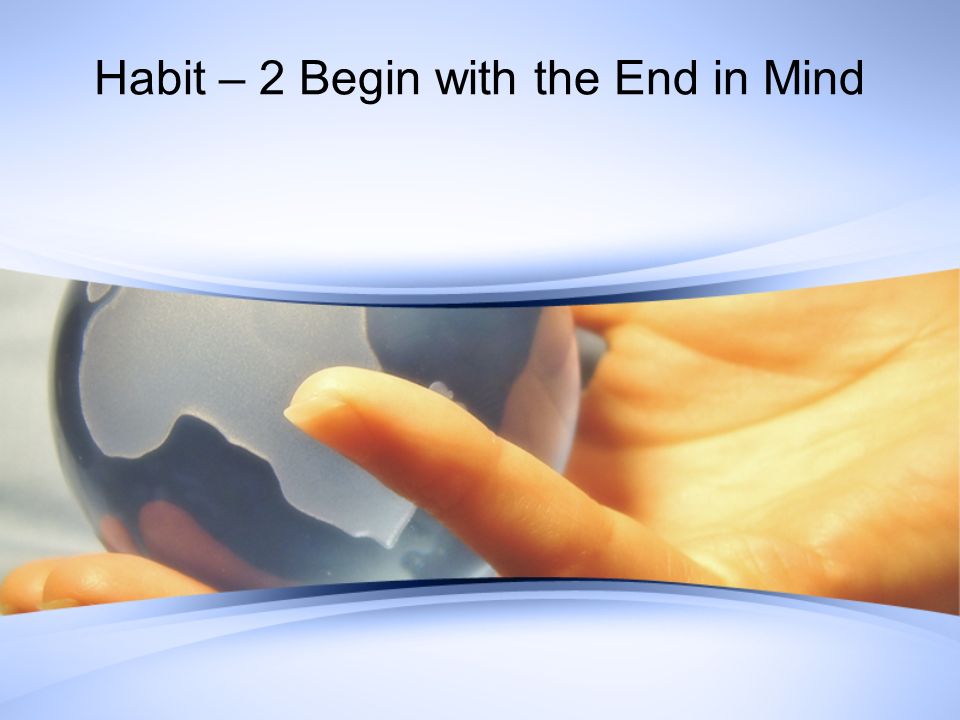
Work Fulfillment: Why Values Matter. Learning Objectives Develop a clear understanding of the meaning of values Develop a clear understanding of the meaning.

The Balanced Life Time Management. Time Management Strategies (< 5 years) Long-Term Goals (> 5 years) Personal Mission Statement Personal Values.

The 7 Habits of Highly Effective People Habit 1: Be Proactive

7 Habits of Highly Effective People

Series on Stephen Covey’s management principles Part-II

Habit – 3 Put first things first. Think about What one thing could you do (that you aren’t doing now) that if you did on a regular basis, would make.

Seven Habits of Highly Effective People

SELF CONTROL Rejecting wrong desires and doing what is right

PRINCIPAL’S COFFEE HABIT ONE FROM THE SEVEN HABITS December 5, 2011 Excerpts taken from The Leader In Me by Steven Covey.

HA405: Leadership and Ethics in Health Care Week 6 Seminar

BECOMING HIGHLY EFFECIVE PEOPLE Accepting targets and working to achieve it.

Are you who you want to be? Jan van Deventer EISLAB October 16, 2006.

Demystifying dementia Module one: Providing person-centred care.

Habit 2 begin with the end in mind

How to Create a Personal MISSION STATEMENT. WINDS OF FATE by Ella Wheeler Wilcox One ship drives east and another drives west. With the selfsame winds.

Dr. Scott W. Kunkel University of San Diego Stephen Covey’s The 7 Habits of Highly Effective People Powerful Lessons in Personal Change Presentation by:

The 7 Habits of Highly Effective People

Learning and Development Developing leaders and managers

Create Your Personal MISSION STATEMENT. BENEFITS OF A MISSION STATEMENT 1.Gives meaning and significance to our actions and our life –At the end of our.
About project
© 2024 SlidePlayer.com Inc. All rights reserved.
- Preferences

Habit 2: Begin with the End in Mind - PowerPoint PPT Presentation

Habit 2: Begin with the End in Mind
Habit 2: begin with the end in mind explains that a personal ... t ruthful. writing a personal mission statement. mission statements can be very personal. ... – powerpoint ppt presentation.
- A Personal Mission Statement
- Habit 2 Begin with the End in Mind explains that a personal mission statement is like a personal credo (philosophy) or motto that states what your life is about.
- Mission Statements come in many varieties. Some are long and some are short. Some are poems and some are songs. Some teens have used their favorite quote as a mission statement. Others have used a picture or a photograph.
- The most important thing is to choose something that will open your eyes to whats really important to you and help you make decisions accordingly.
- Developing a personal mission statement is discovering what youre good at. Everyone has a talent or gift. The secret is figuring out what it is.
- I will live by my own policies.
- I will sleep with a clear conscience.
- I will sleep in peace
- Mary Beth Sylvester
- Emperors New Clothes
- First and foremost, I will remain
- faithful always to my God.
- I will not underestimate the power of family unity.
- I will not neglect a true friend, but will set aside
- time for myself as well.
- I will cross my bridges as I come to them
- (divide and conquer).
- I will begin all challenges with optimism,
- rather than doubt.
- I will always maintain a positive self-image and high self-esteem, knowing that all my intentions begin
- with self-evaluation.
- S ucceeding
- P roductive
- Mission statements can be very personal. Most people start out by writing one, but sometimes, if they have a special talent in an area such as art, they may choose to express their mission through that medium. Your mission will change over time too. It should grow and change as you do. Its a living thing! Writing a mission statement will open your eyes to whats really important to you and will help you make decisions accordingly.
- You never know when a moment and a few sincere words can have an impact on a life.
- - Zig Ziglar
PowerShow.com is a leading presentation sharing website. It has millions of presentations already uploaded and available with 1,000s more being uploaded by its users every day. Whatever your area of interest, here you’ll be able to find and view presentations you’ll love and possibly download. And, best of all, it is completely free and easy to use.
You might even have a presentation you’d like to share with others. If so, just upload it to PowerShow.com. We’ll convert it to an HTML5 slideshow that includes all the media types you’ve already added: audio, video, music, pictures, animations and transition effects. Then you can share it with your target audience as well as PowerShow.com’s millions of monthly visitors. And, again, it’s all free.
About the Developers
PowerShow.com is brought to you by CrystalGraphics , the award-winning developer and market-leading publisher of rich-media enhancement products for presentations. Our product offerings include millions of PowerPoint templates, diagrams, animated 3D characters and more.

Begin with the end in mind!
Jul 30, 2012
590 likes | 842 Views
Begin with the end in mind!. Understand Audience Needs. Stakeholder Analysis WIIFM Typical Presentations Expert Peer Junior. Organised. Attention to Detail. Assertive. Long Attention Span. Quick Decisions. Emotion. Effect of Type. Analytical. Driver. Amiable. Extrovert. Steps.
Share Presentation
- know material
- pointto key area
- general structure
- mind speech maps

Presentation Transcript
Understand Audience Needs • Stakeholder Analysis • WIIFM • Typical Presentations • Expert • Peer • Junior
Organised Attention to Detail Assertive Long Attention Span Quick Decisions Emotion Effect of Type Analytical Driver Amiable Extrovert
Steps Stakeholder Analysis
Discreet Steps • 5-6 minutes – Why? • Creative Process • Phases • Pyramid
Why do we need Structures? • It makes it easy for : • you to write • you to deliver • the audience to understand
General Structure • Start • Middle • Endor • Intro • Body • Conclusion
P.R.E.P. • Proposition or Position • Reason • Example • Proposition or Position
Chronological • Past • Present • Future
Future Fix • Problem • Cause • Solution
A.I.D.A. • Attention • Interest • Desire • Action
3 Tells • Tell ‘Em • Tell ‘Em • Tell ‘Em
Story • Must have no opening summary • Must prompt question –“What happens next” • Leave “Open Loops”
Story Structure • Set the scene • Introduce the characters • Begin the journey • Encounter the obstacle • Overcome the obstacle • Resolve the story • Make the point
What’s coming next?
Grab Their Attention • 6 Great Starts • Story • A question • Past or Future • A fact or statistic • Analogy • Saying or quotation
Leave them on a high • Use • Emotions • Calls to Actions • Sense of Achievement
KISS • Timing • Use 120 words a minute as a guide • Make it understood • Aim for 4-6 letter per word
Additional Passes • To add relevance and reality • To add humour • To add Body Language and Props
Add impact with PowerPoint • What it’s good at • What it’s not • Powerful Titles
90% Hear SeeSay Do 60% Do 50% Say 40% See 30% Hear 20% Read Why Involve the Audience? How We Remember
Pointto Key Area
Nerves? (http://www.joyrides.com)
Overcoming Nerves • Be familiar with the environment • Know material well • Know Audience • Know Room • Concentrate on Message • Don’t apologize • Be prepared • Practice
Notes • Always have available • Use as you need • Try different types • Use Treasury Tag • Try Mind/Speech Maps
Effective Rehearsal • Write on 6”x4” cards • Rehearse Randomly • Tape yourself • Play back in car
In Control with Q&A • Listen • Clarify and make positive • Are they comfortable • You don’t have to answer • Stay on target • Use a structure • Take off-line • Don’t counter punch
- More by User
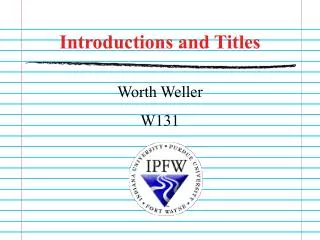
Introductions and Titles
Introductions and Titles. Worth Weller W131. To Begin or Not To Begin. Keep the following in mind: You do not need to begin writing your essay with either a title or introduction in mind
815 views • 18 slides
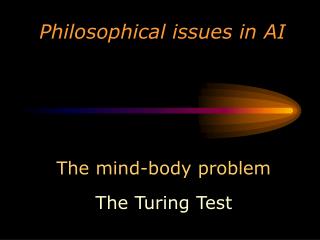
Philosophical issues in AI
Philosophical issues in AI. The mind-body problem The Turing Test. The mind-body problem. Recall the question “Where does the body end and the mind begin?” Where one ends and the other begins in the context of intelligence is the mind-body problem. Is the mind separate from the body?.
535 views • 6 slides

Click your mouse to begin presentation
Click your mouse to begin presentation. Shem’s New Age Music is in Power Today…. … and is trapping your MIND… …and your children’s mind…. with what they call…. The Mozart Effect. The Satanic Power of Good Music. The Mozart Effect.
521 views • 31 slides

Philosophy of Mind
Philosophy of Mind. I. Introduction II. Ontological Issues. I. Introduction. The philosophy of mind: Attempts to answer the questions like: - Does the mind exist? - What is the nature of the mind? - How is the mind related to the body (i.e., brain)? - Can a machine have a mind?
963 views • 15 slides

Digital Citizenship Advisory Committee for SSB 6273
Digital Citizenship Advisory Committee for SSB 6273. SECOND Meeting – SEPTEMBER 28, 2016. This work is licensed under a Creative Commons Attribution 4.0 International License. Today’s Agenda. Introductions “ Mini case studies” on: Addressing Media Literacy at Seattle Prep
738 views • 59 slides
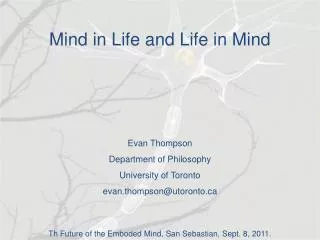
Mind in Life and Life in Mind
Mind in Life and Life in Mind. Evan Thompson Department of Philosophy University of Toronto [email protected]. Th Future of the Emboded Mind, San Sebastian, Sept. 8, 2011. Guiding questions. How is life related to mind and mind related to life?
960 views • 62 slides
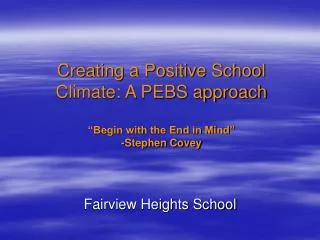
Creating a Positive School Climate: A PEBS approach “Begin with the End in Mind” -Stephen Covey
Creating a Positive School Climate: A PEBS approach “Begin with the End in Mind” -Stephen Covey. Fairview Heights School. People will forget what you said… People will forget what you did…. But people will never forget how you made them feel… Albert, 1996.
576 views • 42 slides

Wittgenstein
Begin by mind mapping as many words as you can think of that are associated with the word
560 views • 16 slides
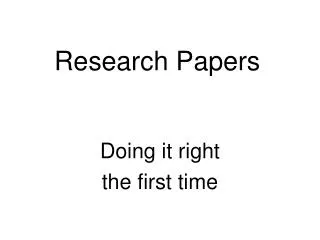
Research Papers
Research Papers. Doing it right the first time. How to begin. The best researchers keep an open mind going into their research process. They do NOT begin researching with a set-in-stone predetermined outcome in mind.
310 views • 21 slides

Help sheet: mind map
Help sheet: mind map. A mind map is a diagram used to visually outline information. A mind map is often created around a single word or concept idea in which associated words, ideas and concepts are then branched off.
146 views • 1 slides
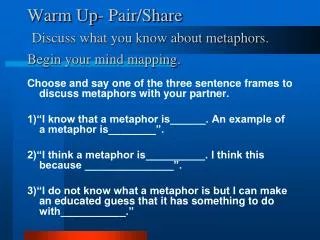
Warm Up- Pair/Share Discuss what you know about metaphors . Begin your mind mapping.
Warm Up- Pair/Share Discuss what you know about metaphors . Begin your mind mapping. Choose and say one of the three sentence frames to discuss metaphors with your partner. 1)“I know that a metaphor is______. An example of a metaphor is________”.
376 views • 18 slides

Begin with empty bowl, empty mind
Skin Heal Salve How to Make an All Purpose Healing Salve in your own kitchen with Judy Harmon Clinical Herbalist for Herb U An online university of herbal medicine. Begin with empty bowl, empty mind . Light a candle, take a breath. Begin. Collect all Ingredients. Recipe Ingredients
365 views • 27 slides

What is it to Have a Mind?
What is it to Have a Mind?. What is it to Have a Mind?. Two Central Questions: What are minds? How do minds relate to/interact with bodies?. What is it to Have a Mind?. Recall our list of mental states: Thoughts Beliefs Desires Current experiences and sensations Emotions.
965 views • 82 slides
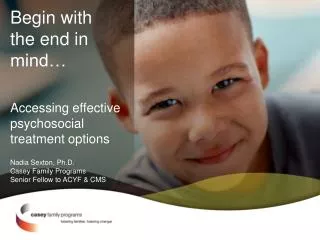
Begin with the end in mind…
Begin with the end in mind…. Accessing effective psychosocial treatment options Nadia Sexton, Ph.D. Casey Family Programs Senior Fellow to ACYF & CMS. Medicaid Expenditures for Children in Child Welfare
384 views • 21 slides
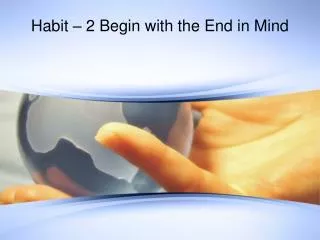
Habit – 2 Begin with the End in Mind
Habit – 2 Begin with the End in Mind. Principles of Personal leadership. The Funeral Question: Imagine its your funeral! What would you like a speaker to say about you and your life? Reflect individually and write it down. What it means to begin with the end in mind.
2.41k views • 13 slides
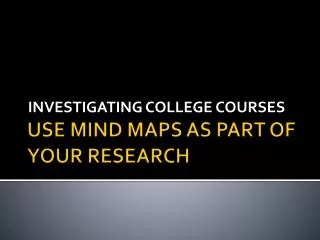
USE MIND MAPS AS PART OF YOUR RESEARCH
INVESTIGATING COLLEGE COURSES. USE MIND MAPS AS PART OF YOUR RESEARCH. How to create a mind map. Why Mind Maps?. Why use Mind Maps? Mind Maps will help your memory Mind Maps will help you get organised Mind Maps can save you time
305 views • 9 slides

BINGO GENERAL OVERVIEW 7 HABITS BE PROACTIVE BEGIN WITH THE END IN MIND
BINGO GENERAL OVERVIEW 7 HABITS BE PROACTIVE BEGIN WITH THE END IN MIND SEEK 1 st TO UNDERSTAND, THEN BE UNDERSTOOD THE RELEASE OF THE SPIRIT. BROKEN UP INTO 3 SECTIONS. PRIVATE VICTORY PUBLIC VICTORY RENEWAL. PRIVATE VICTORY- 3 HABITS. 1. BE PROACTIVE 2. BEGIN WITH THE END IN MIND
303 views • 17 slides

Begin with the End in Mind
Begin with the End in Mind. Danielle Cohn,Neena Milton,Raquel Espinoza,Vanessa Martinez & Ariana Arevalo-Losoya. Always have a Mission Statement. A mission statement is: A summary describing the aims , values , and overall plan of an organization or individual.
230 views • 7 slides
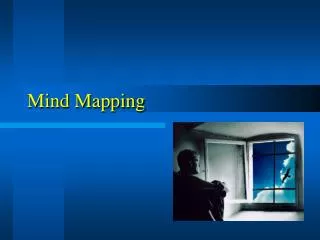
Mind Mapping
Mind Mapping. Mind Map Sample. What is a Mind Map?. Mind map is a tool which helps you think and learn. Shows the structure of the subject and linkages between points as well as the raw facts contained in normal notes.
369 views • 7 slides
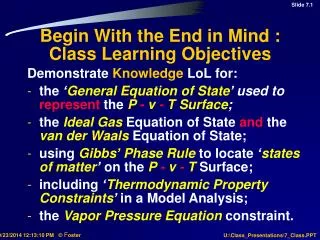
Begin With the End in Mind : Class Learning Objectives
Begin With the End in Mind : Class Learning Objectives. Demonstrate Knowledge LoL for: the ‘ General Equation of State ’ used to represent the P - v - T Surface ; the Ideal Gas Equation of State and the van der Waals Equation of State;
465 views • 30 slides
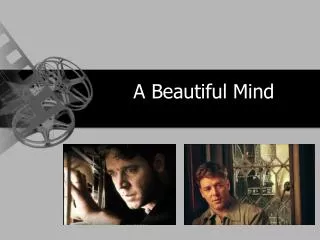
A Beautiful Mind
A Beautiful Mind. A Beautiful Mind. A Beautiful Mind. A portrait of an intricate puzzle of the mind. Inspired by the story of Nobel Prize-winning mathematician John Forbes Nash Jr. whose genius is intimately bound up with schizophrenia .
819 views • 12 slides
- Beyond The Hype
Mind Over Money: Beginning With The End In Mind
It often seems counter-intuitive for most young people. However, understanding and preparing for long-term goals like retirement—including the future lifestyle you desire and how you will pay for it—should be a focus in the early stages of adult life, not to be put off for later. New York Life Licensed Agent Roderick Carr joins Beyond The Hype to share why the earlier you start, the more you can leverage the most valuable asset of youth—time—to your advantage.
Purdue Online Writing Lab Purdue OWL® College of Liberal Arts
Welcome to the Purdue Online Writing Lab

Welcome to the Purdue OWL
This page is brought to you by the OWL at Purdue University. When printing this page, you must include the entire legal notice.
Copyright ©1995-2018 by The Writing Lab & The OWL at Purdue and Purdue University. All rights reserved. This material may not be published, reproduced, broadcast, rewritten, or redistributed without permission. Use of this site constitutes acceptance of our terms and conditions of fair use.
The Online Writing Lab at Purdue University houses writing resources and instructional material, and we provide these as a free service of the Writing Lab at Purdue. Students, members of the community, and users worldwide will find information to assist with many writing projects. Teachers and trainers may use this material for in-class and out-of-class instruction.
The Purdue On-Campus Writing Lab and Purdue Online Writing Lab assist clients in their development as writers—no matter what their skill level—with on-campus consultations, online participation, and community engagement. The Purdue Writing Lab serves the Purdue, West Lafayette, campus and coordinates with local literacy initiatives. The Purdue OWL offers global support through online reference materials and services.
A Message From the Assistant Director of Content Development
The Purdue OWL® is committed to supporting students, instructors, and writers by offering a wide range of resources that are developed and revised with them in mind. To do this, the OWL team is always exploring possibilties for a better design, allowing accessibility and user experience to guide our process. As the OWL undergoes some changes, we welcome your feedback and suggestions by email at any time.
Please don't hesitate to contact us via our contact page if you have any questions or comments.
All the best,
Social Media
Facebook twitter.

'3 Body Problem' Renewed Through the Novels' 'Epic Conclusion'
"3 Body Problem" will officially be returning to Netflix. The news was announced as part of the streamer's upfront presentation in New York City on Wednesday.
The series will continue "with all-new episodes to take viewers through the full journey of this epic saga," according to a press release. Upcoming episodes of the series will be created, executive produced and written by the returning trio of David Benioff, D.B. Weiss and Alexander Woo.
Exactly how many seasons and episodes this renewal entails will be revealed at a later date.
"We're thrilled that we get to tell this story through to its epic conclusion," the three creators said in a statement to press. "Ever since we read the last page of Cixin Liu's magnificent trilogy, we hoped we'd be able to bring the audience to the end of the universe with us. Here we go!"
"The extraordinary '3 Body Problem,' brought to life with the deft hands of
Benioff, Weiss and Woo, will soar to never-before-seen heights as they tackle
the rest of the mind-blowing journey through 'Death's End.' Their brilliant vision
as storytellers is matched by their amazing partnership -- and, just like the fans, we can't wait to see what they have in store," Peter Friedlander, vice president of scripted series in the U.S. and Canada for Netflix, said in a statement.
Additionally, Benioff and Weiss re-upped their exclusive multi-year deal to write, produce and direct new series and films at Netflix. As well as continuing "3 Body Problem," the duo is currently working on the Michael Shannon and Matthew Macfadyen drama "Death by Lightning."
"3 Body Problem" starts with one woman's fateful decision in 1960s China during the Cultural Revolution. Decades later, a group of brilliant friends from Oxford find themselves roped into confronting an alien threat that has the potential to destroy humanity. The series is based on Liu's "Remembrances of Earth's Past" trilogy, which is composed of "The Three-Body Problem," "The Dark Forest" and "Death's End."
Netflix's adaptation of the sci-fi novel has been a success for the company. The series spent three weeks in the No. 1 spot on the streamer's Global Top 10 list and spent seven weeks total on the list. It also reached the Top 10 list in 93 countries.
The post '3 Body Problem' Renewed Through the Novels' 'Epic Conclusion' appeared first on TheWrap .

Apple unveils stunning new iPad Pro with the world’s most advanced display, M4 chip, and Apple Pencil Pro
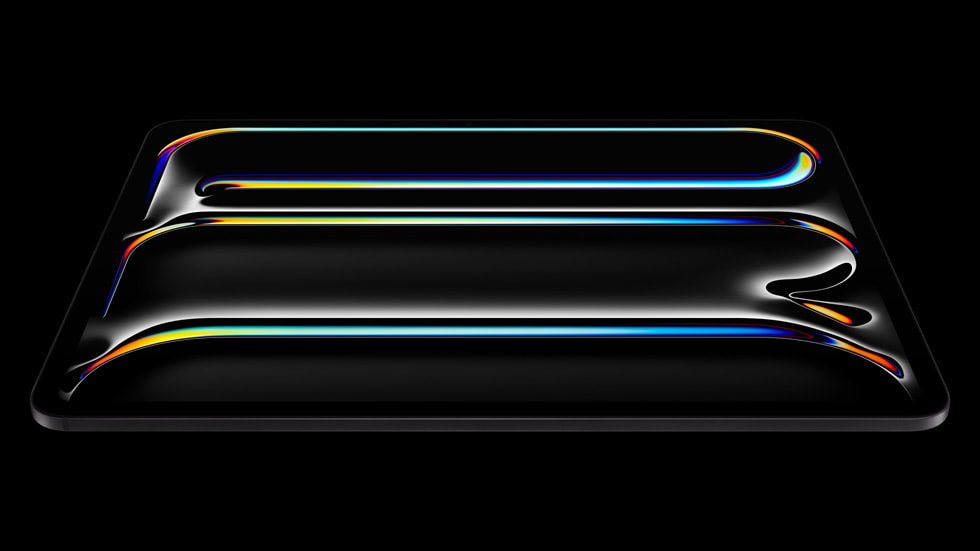
Thinnest Apple Product Ever
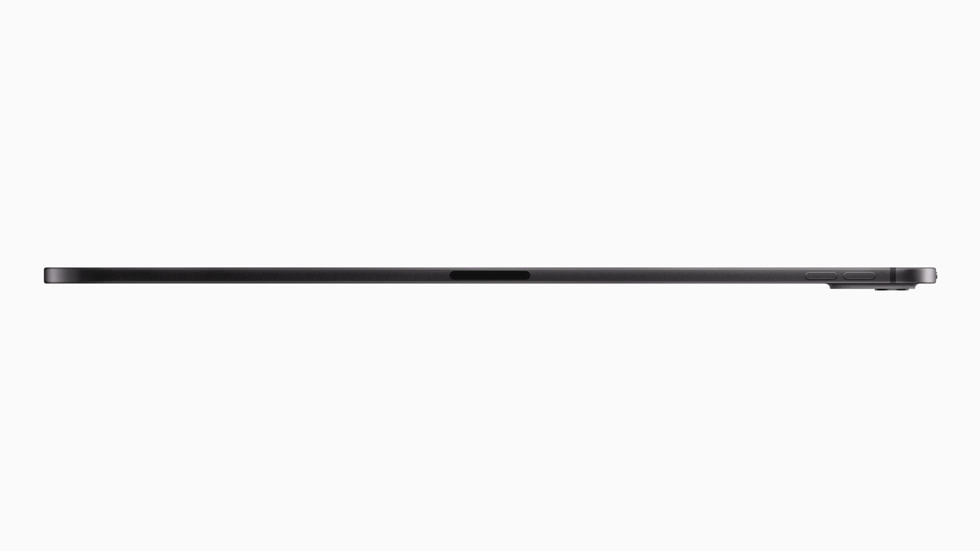
World’s Most Advanced Display
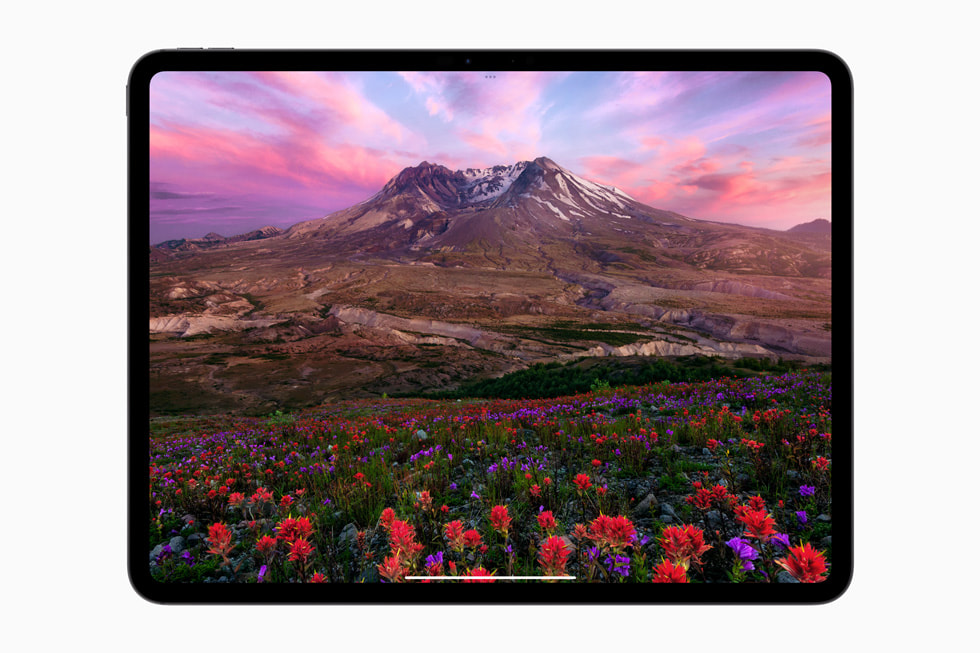
Only Possible with M4
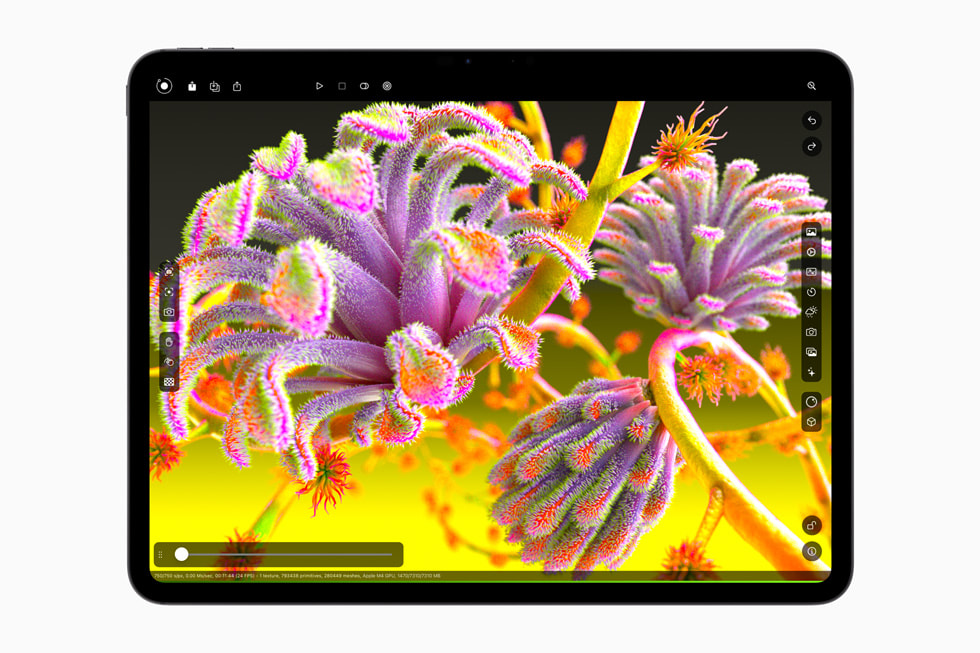
Outrageously Powerful Device for AI
Pro Cameras
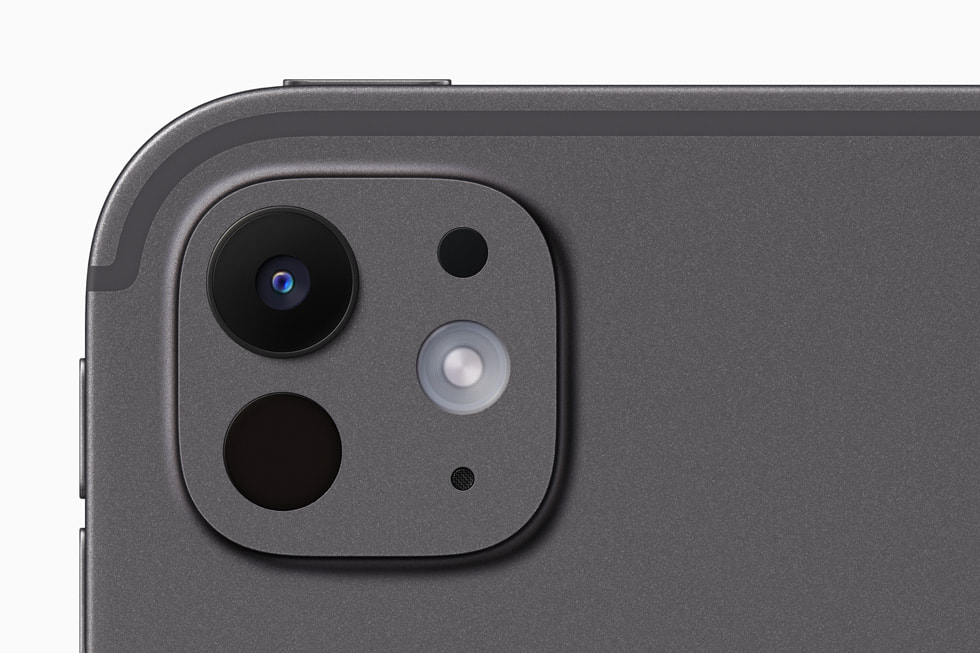
Pro Connectivity
Apple Pencil Pro
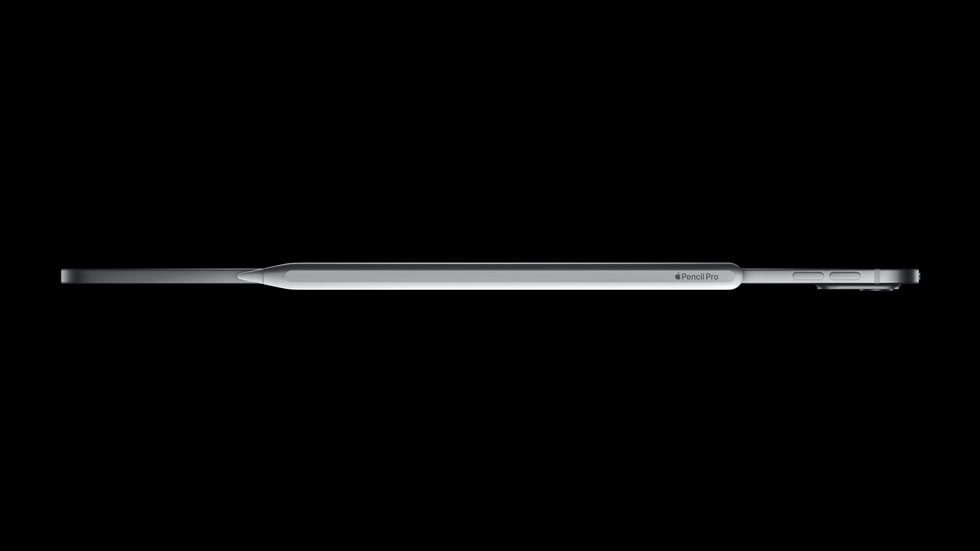
All-New Magic Keyboard and Smart Folio
Powerful iPadOS Features
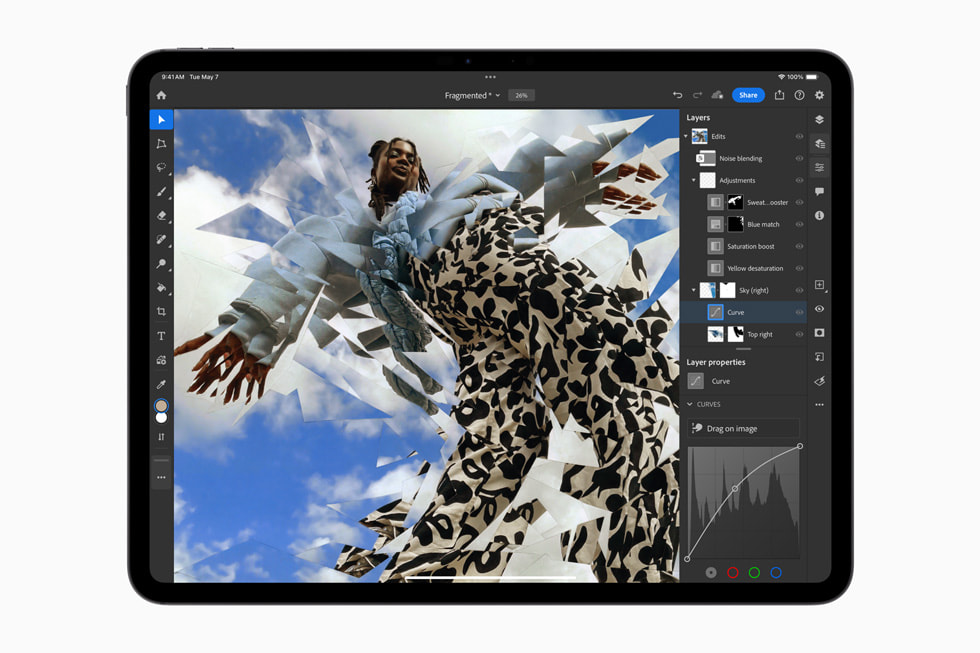
Logic Pro for iPad 2
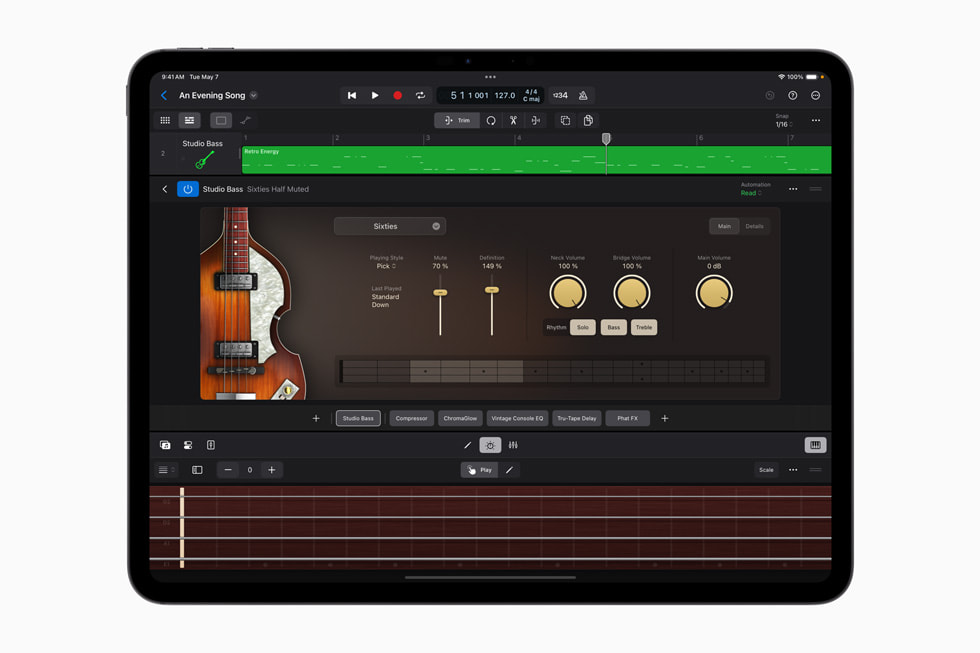
Final Cut Pro for iPad 2
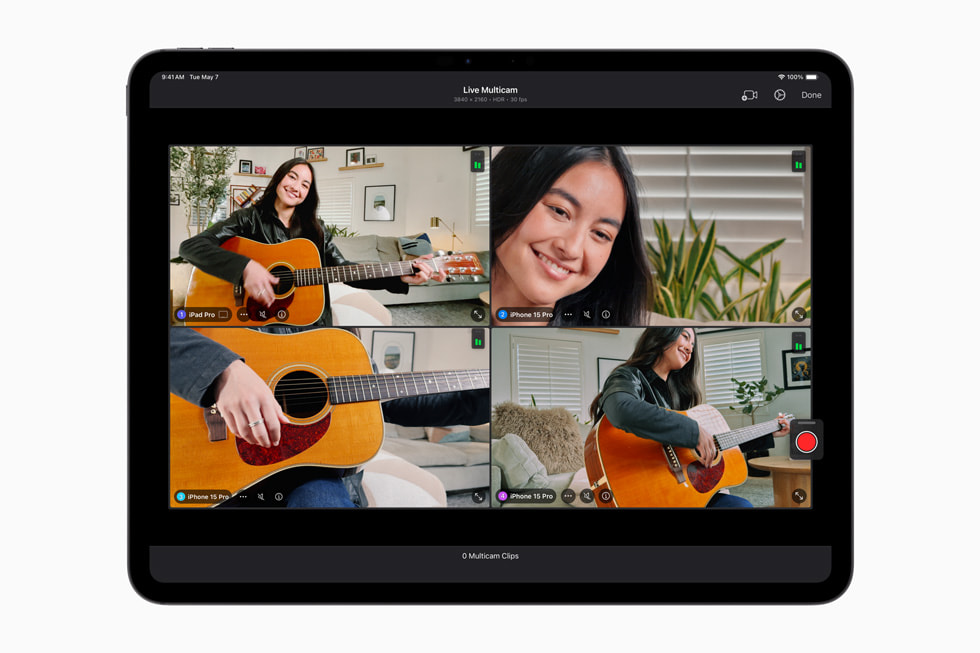
iPad Pro and the Environment
- Customers can order the new iPad Pro with M4 starting today, May 7, at apple.com/store , and in the Apple Store app in 29 countries and regions, including the U.S., with availability in stores beginning Wednesday, May 15.
- The new 11-inch and 13-inch iPad Pro will be available in silver and space black finishes in 256GB, 512GB, 1TB, and 2TB configurations.
- The 11-inch iPad Pro starts at $999 (U.S.) for the Wi-Fi model, and $1,199 (U.S.) for the Wi-Fi + Cellular model. The 13-inch iPad Pro starts at $1,299 (U.S.) for the Wi-Fi model, and $1,499 (U.S.) for the Wi-Fi + Cellular model. Additional technical specifications, including nano-texture glass options, are available at apple.com/store .
- For education, the new 11-inch iPad Pro is available for $899 (U.S.) and the 13-inch iPad Pro is $1,199 (U.S.). Education pricing is available to current and newly accepted college students and their parents, as well as faculty, staff, and home-school teachers of all grade levels. For more information, visit apple.com/us-hed/shop .
- The new Apple Pencil Pro is compatible with the new iPad Pro. It is available for $129 (U.S.). For education, Apple Pencil Pro is available for $119 (U.S.).
- Apple Pencil (USB-C) is compatible with the new iPad Pro. It is available for $79 (U.S.) and $69 (U.S.) for education.
- The new Magic Keyboard is compatible with the new iPad Pro. It is available in black and white finishes. The new 11-inch Magic Keyboard is available for $299 (U.S.) and the new 13-inch Magic Keyboard is available for $349 (U.S.), with layouts for over 30 languages. For education, the 11-inch Magic Keyboard is available for $279 (U.S.) and the 13-inch Magic Keyboard is available for $329 (U.S.).
- The new Smart Folio is available for $79 (U.S.) in black, white, and denim finishes for the new 11-inch iPad Pro and $99 (U.S.) for the new 13-inch iPad Pro.
- Logic Pro for iPad 2 is available on May 13 as a free update for existing users, and for new users, it is available on the App Store for $4.99 (U.S.) per month, or $49 (U.S.) per year, with a one-month free trial. Logic Pro for iPad 2 requires iPadOS 17.4 or later. For more information, visit apple.com/logic-pro-for-ipad .
- Final Cut Pro for iPad 2 will be available later this spring on the App Store for $4.99 (U.S.) per month, or $49 (U.S.) per year, with a one-month free trial.
- Apple offers great ways to save on the latest iPad. Customers can trade in their current iPad and get credit toward a new one by visiting the Apple Store online , the Apple Store app, or an Apple Store location. To see what their device is worth, and for terms and conditions, customers can visit apple.com/shop/trade-in .
- Customers in the U.S. who shop at Apple using Apple Card can pay monthly at 0 percent APR when they choose to check out with Apple Card Monthly Installments, and they’ll get 3 percent Daily Cash back — all upfront.
Text of this article
May 7, 2024
PRESS RELEASE
Featuring a new thin and light design, breakthrough Ultra Retina XDR display, and outrageously fast M4 performance with powerful AI capabilities, the new iPad Pro takes a huge leap forward
CUPERTINO, CALIFORNIA Apple today unveiled the groundbreaking new iPad Pro in a stunningly thin and light design, taking portability and performance to the next level. Available in silver and space black finishes, the new iPad Pro comes in two sizes: an expansive 13-inch model and a super-portable 11-inch model. Both sizes feature the world’s most advanced display — a new breakthrough Ultra Retina XDR display with state-of-the-art tandem OLED technology — providing a remarkable visual experience. The new iPad Pro is made possible with the new M4 chip, the next generation of Apple silicon, which delivers a huge leap in performance and capabilities. M4 features an entirely new display engine to enable the precision, color, and brightness of the Ultra Retina XDR display. With a new CPU, a next-generation GPU that builds upon the GPU architecture debuted on M3, and the most powerful Neural Engine yet, the new iPad Pro is an outrageously powerful device for artificial intelligence. The versatility and advanced capabilities of iPad Pro are also enhanced with all-new accessories. Apple Pencil Pro brings powerful new interactions that take the pencil experience even further, and a new thinner, lighter Magic Keyboard is packed with incredible features. The new iPad Pro, Apple Pencil Pro, and Magic Keyboard are available to order starting today, with availability in stores beginning Wednesday, May 15.
“iPad Pro empowers a broad set of pros and is perfect for anyone who wants the ultimate iPad experience — with its combination of the world’s best displays, extraordinary performance of our latest M-series chips, and advanced accessories — all in a portable design. Today, we’re taking it even further with the new, stunningly thin and light iPad Pro, our biggest update ever to iPad Pro,” said John Ternus, Apple’s senior vice president of Hardware Engineering. “With the breakthrough Ultra Retina XDR display, the next-level performance of M4, incredible AI capabilities, and support for the all-new Apple Pencil Pro and Magic Keyboard, there’s no device like the new iPad Pro.”
The new iPad Pro — the thinnest Apple product ever — features a stunningly thin and light design, taking portability to a whole new level. The 11-inch model is just 5.3 mm thin, and the 13-inch model is even thinner at a striking 5.1 mm, while both models are just as strong as the previous design. The 11-inch model weighs less than a pound, and the 13-inch model is nearly a quarter pound lighter than its predecessor — allowing pro users to extend their workflows in new ways and in more places. The new iPad Pro is available in two gorgeous finishes — silver and space black — both with 100 percent recycled aluminum enclosures.
The new iPad Pro debuts the Ultra Retina XDR, the world’s most advanced display, to provide an even more remarkable visual experience. The Ultra Retina XDR display features state-of-the-art tandem OLED technology that uses two OLED panels and combines the light from both to provide phenomenal full-screen brightness. The new iPad Pro supports an incredible 1000 nits of full-screen brightness for SDR and HDR content, and 1600 nits peak for HDR. No other device of its kind delivers this level of extreme dynamic range. Tandem OLED technology enables sub-millisecond control over the color and luminance of each pixel, taking XDR precision further than ever. Specular highlights in photos and video appear even brighter, and there’s more detail in shadows and low light than ever before on iPad — all while delivering even more responsiveness to content in motion. For pro users working in high-end, color-managed workflows or challenging lighting conditions, a new nano-texture glass option comes to iPad Pro for the first time. 1 Nano-texture glass is precisely etched at a nanometer scale, maintaining image quality and contrast while scattering ambient light for reduced glare. With its breakthrough tandem OLED technology, extreme brightness, incredibly precise contrast, brilliant colors, and nano-texture glass option, the new Ultra Retina XDR display is the world’s most advanced display, giving iPad Pro customers an unparalleled viewing experience.
The incredibly thin and light design and game-changing display of the new iPad Pro is only possible with M4, the next generation of Apple silicon that delivers a huge leap in performance. M4 is built on second-generation 3-nanometer technology that’s even more power efficient, which is perfect for the design of the new iPad Pro. With an entirely new display engine, M4 introduces pioneering technology for the stunning precision, color, and brightness of the Ultra Retina XDR display. The new CPU offers up to four performance cores and now six efficiency cores, 2 with next-generation machine learning (ML) accelerators, to deliver up to 1.5x faster CPU performance over M2 in the previous-generation iPad Pro. 3 M4 builds on the GPU architecture of M3 — the 10-core GPU includes powerful features like Dynamic Caching, and hardware-accelerated mesh shading and ray tracing, which come to iPad for the first time. Coupled with higher unified memory bandwidth, pro rendering apps like Octane will see up to 4x faster performance than M2. 3 M4 also delivers tremendous gains and industry-leading performance per watt. Compared to M2, M4 can deliver the same performance using just half the power, and compared to the latest PC chip in a thin and light laptop, M4 can deliver the same performance using just a quarter of the power. 4 A new advanced Media Engine includes support for AV1 decode, providing more power-efficient playback of high-resolution video experiences from streaming services.
The new iPad Pro with M4 features Apple’s most powerful Neural Engine ever, capable of 38 trillion operations per second, which is 60x faster than Apple’s first Neural Engine in the A11 Bionic chip. Combined with next-generation ML accelerators in the CPU, a high-performance GPU, more memory bandwidth, and intelligent features and powerful developer frameworks in iPadOS, the Neural Engine makes the new iPad Pro an outrageously powerful device for AI. With iPad Pro with M4, users can perform AI-enabled tasks even faster, like easily isolate a subject from its background in 4K video with just a tap with Scene Removal Mask in Final Cut Pro. With this advanced level of performance, the Neural Engine in M4 is more powerful than any neural processing unit in any AI PC today.
iPadOS also has advanced frameworks like Core ML that make it easy for developers to tap into the Neural Engine to deliver phenomenal AI features locally, including running powerful diffusion and generative AI models, with great performance on device. iPad Pro also supports cloud-based solutions, enabling users to run powerful productivity and creative apps that tap into the power of AI, such as Copilot for Microsoft 365 and Adobe Firefly.
The updated camera system on the new iPad Pro delivers even more versatility, and with its rich audio from four studio-quality mics, users can shoot, edit, and share all on one device. The 12MP back camera captures vibrant Smart HDR images and video with even better color, improved textures, and detail in low light. It also now features a new adaptive True Tone flash that makes document scanning on the new iPad Pro better than ever. Using AI, the new iPad Pro automatically identifies documents right in the Camera app, and if a shadow is in the way, it instantly takes multiple photos with the new adaptive flash, stitching the scan together for a dramatically better scan.
On the front, the TrueDepth camera system moves to the landscape location on the new iPad Pro. The Ultra Wide 12MP camera with Center Stage makes the experience of video conferencing in landscape orientation even better, especially when iPad is attached to a Magic Keyboard or Smart Folio.
iPad Pro includes a high-performance USB-C connector with support for Thunderbolt 3 and USB 4, delivering fast wired connectivity — up to 40Gb/s. Thunderbolt supports an extensive ecosystem of high-performance accessories, including external displays like the Pro Display XDR at its full 6K resolution, and external storage, all connected using high-performance cables and docks. iPad Pro supports Wi-Fi 6E for super-fast Wi-Fi connections for pro workflows on the go. Wi-Fi + Cellular models with 5G allow users to access their files, communicate with colleagues, and back up their data in a snap while on the go. Cellular models of the new iPad Pro are activated with eSIM, a more secure alternative to a physical SIM card, allowing users to quickly connect and transfer their existing plans digitally, and store multiple cellular plans on a single device. Customers can easily get connected to wireless data plans on the new iPad Pro in over 190 countries and regions around the world without needing to get a physical SIM card from a local carrier.
Apple Pencil Pro features even more magical capabilities and powerful new interactions that take the Apple Pencil experience even further. A new sensor in the barrel can sense a user’s squeeze, bringing up a tool palette to quickly switch tools, line weights, and colors, all without interrupting the creative process. A custom haptic engine delivers a light tap that provides confirmation when users squeeze, use double-tap, or snap to a Smart Shape for a remarkably intuitive experience. A gyroscope allows users to roll Apple Pencil Pro for precise control of the tool they’re using. Rotating the barrel changes the orientation of shaped pen and brush tools, just like pen and paper. And with Apple Pencil hover, users can visualize the exact orientation of a tool before making a mark.
With these advanced features, Apple Pencil Pro allows users to bring their ideas to life in entirely new ways, and developers can also create their own custom interactions. Apple Pencil Pro brings support for Find My for the first time to Apple Pencil, helping users locate Apple Pencil Pro if misplaced. It pairs, charges, and is stored on the side of iPad Pro through a new magnetic interface. iPad Pro also supports Apple Pencil (USB-C), ideal for note taking, sketching, annotating, journaling, and more, at an incredible value.
Designed for the new iPad Pro, an all-new thinner and lighter Magic Keyboard makes it more portable and versatile than ever. The new Magic Keyboard opens to the magical floating design that customers love, and now includes a function row for access to features like screen brightness and volume controls. It also has a gorgeous aluminum palm rest and larger trackpad that’s even more responsive with haptic feedback, so the entire experience feels just like using a MacBook. The new Magic Keyboard attaches magnetically, and the Smart Connector immediately connects power and data without the need for Bluetooth. The machined aluminum hinge also includes a USB-C connector for charging. The new Magic Keyboard comes in two colors that perfectly complement the new iPad Pro: black with a space black aluminum palm rest, and white with a silver aluminum palm rest.
The new Smart Folio for iPad Pro attaches magnetically and now supports multiple viewing angles for greater flexibility. Available in black, white, and denim, it complements the colors of the new iPad Pro.
iPadOS is packed with features that push the boundaries of what’s possible on iPad. With Reference Mode, iPadOS can precisely match color requirements of the Ultra Retina XDR display for tasks in which accurate colors and consistent image quality are critical — including review and approve, color grading, and compositing. Stage Manager enables users to work with multiple overlapping windows in a single view, resize windows, tap to switch between apps, and more. With full external display support of up to 6K, iPad Pro users can also extend their workflow, as well as use the built-in camera on an external display for enhanced video conferencing. Users can take advantage of the powerful AI capabilities in iPad Pro and intelligent features in iPadOS, including Visual Look Up, Subject Lift, Live Text, or Live Captions and Personal Voice for accessibility.
With iPadOS 17 , users can customize the Lock Screen to make it more personal — taking advantage of the larger display on iPad — and interactive widgets take glanceable information further with the ability to get tasks done right in the moment with just a tap. The Notes app gives users new ways to organize, read, annotate, and collaborate on PDFs, and working with PDFs is also easier with AutoFill, which intelligently identifies and fills fields in forms.
Logic Pro for iPad 2 , available starting Monday, May 13, introduces incredible studio assistant features that augment the music-making process and provide artists help right when they need it — all while ensuring they maintain full creative control. These features include Session Players, which expand on popular Drummer capabilities in Logic to include a new Bass Player and Keyboard Player; ChromaGlow, to instantly add warmth to tracks; and Stem Splitter, to extract and work with individual parts of a single audio recording.
Final Cut Pro for iPad 2 , available later this spring, introduces Live Multicam, a new feature that transforms iPad into a mobile production studio, allowing users to view and control up to four connected iPhone and iPad devices wirelessly. 5 To support Live Multicam, an all-new capture app also comes to iPad and iPhone, Final Cut Camera, 6 giving users control over options like white balance, ISO, and shutter speed, along with monitoring tools like overexposure indicators and focus peaking. Final Cut Camera works as a standalone capture app or with Live Multicam. Final Cut Pro for iPad 2 also allows users to create or open projects from external storage, giving editors even more flexibility, and offers new content options. 7
The new iPad Pro is designed with the environment in mind, including 100 percent recycled aluminum in the enclosure, 100 percent recycled rare earth elements in all magnets, and 100 percent recycled gold plating and tin soldering in multiple printed circuit boards. The new iPad Pro meets Apple’s high standards for energy efficiency, and is free of mercury, brominated flame retardants, and PVC. The packaging is 100 percent fiber-based, bringing Apple closer to its goal to remove plastic from all packaging by 2025.
Today, Apple is carbon neutral for global corporate operations, and by 2030, plans to be carbon neutral across the entire manufacturing supply chain and life cycle of every product.
Pricing and Availability
- Nano-texture glass is an option on the 1TB and 2TB configurations of the 11-inch and 13-inch iPad Pro models.
- iPad Pro models with 256GB or 512GB storage feature the Apple M4 chip with a 9‑core CPU. iPad Pro models with 1TB or 2TB storage feature the Apple M4 chip with a 10‑core CPU.
- Testing was conducted by Apple in March and April 2024. See apple.com/ipad-pro for more information.
- Testing was conducted by Apple in March and April 2024 using preproduction 13-inch iPad Pro (M4) units with a 10-core CPU and 16GB of RAM. Performance was measured using select industry‑standard benchmarks. PC laptop chip performance data is from testing ASUS Zenbook 14 OLED (UX3405MA) with Core Ultra 7 155H and 32GB of RAM. Performance tests are conducted using specific computer systems and reflect the approximate performance of iPad Pro.
- Final Cut Pro for iPad 2 is compatible with iPad models with the M1 chip or later, and Logic Pro for iPad 2 will be available on iPad models with the A12 Bionic chip or later.
- Final Cut Camera is compatible with iPhone X S and later with iOS 17.4 or later, and iPad models compatible with iPadOS 17.4 or later.
- External project support requires iPadOS 17.5 or later.
Press Contacts
Tara Courtney
Apple Media Helpline
Images in this article

COMMENTS
Habit 2: Begin With the End in Mind®. Define clear measures of success and a plan to achieve them. Habit 3: Put First Things First®. Prioritize and achieve your most important goals instead of constantly reacting to urgencies. Habit 4: Think Win-Win®. Collaborate more effectively by building high-trust relationships.
Oct 9, 2009 • Download as PPTX, PDF •. 50 likes • 76,402 views. danielleisathome. Education Health & Medicine. 1 of 12. Download now. Begin With The End In Mind 1 - Download as a PDF or view online for free.
Learn what this philosophy is and why it's important to visualize your life, career, or project the way you want it to end up. Follow a simple five-step process to begin with the end in mind today and achieve your goals with clarity, efficiency, and purpose.
February 15th, 2024 6 min read. Summary. "Begin with the end in mind" is the second of the seven habits of highly effective people Dr. Stephen R. Covey defines in his bestselling book. The habit is based on the principle that all things are created twice: once in your mind and once in the physical world. In this article, you'll learn how to ...
Habit 2 Begin with the end in mind.pptx. Jul 4, 2023 • Download as PPTX, PDF •. 0 likes • 58 views. N. Neelesh Pandey. ghrturtn. Presentations & Public Speaking. 1 of 15. Download now.
Self Improvement. 1 of 17. Download now. 1. Habit #2 Begin with the End in Mind Supatcha, Chonnikan, Kantapong, Kamollak P5. 2. o Begin with the End in Mind means developing a clear picture of where you want to go with your life. o Deciding what your values are o Setting Goals. 3. Begin with the End in Mind—What It Means o Good reasons to ...
Instead of starting from the beginning (first I say this, then I say that, etc.) you should start from the end. Start with your final message - the idea that sums up your presentation - and ...
"Begin with the end in mind" is the first habit and thus likely the most important. You can apply this first habit from Stephen Covey's leadership prinpcles to your presentation in three ways. 1. Develop your presentation with the end in mind. The first thing that you should do is to write a short simple statement that clarifies your purpose.
Presentation on theme: "Habit 2 begin with the end in mind"— Presentation transcript: 1 Habit 2 begin with the end in mind It is good to have an end to journey toward, but it is the journey that matters in the end.
The Seven Habits of Highly Effective Teens by Sean Covey. Download ppt "Habit #2: Begin with the end in mind". Begin with the end in mind - have a plan I plan ahead and set goals. I do things that have meaning and make a difference. I am an important part of my classroom and contribute to my school's mission and vision.
Presentation on theme: "Begin with the End in Mind"— Presentation transcript: 1 Begin with the End in Mind. Habit Two Begin with the End in Mind. 2 We do it all the time . . . Read a recipe before we bake a cake. Look at the picture before assembling the puzzle Draw blueprints before building a house Plan a trip before buying plane tickets We ...
Mission Statement Builder. FranklinCovey Podcast. The 7 Habits of Highly Effective People. 01. Habit 1: Be Proactive®. Focus and act on what you can control and influence instead of what you can't. 02. Habit 2: Begin With the End in Mind®. Define clear measures of success and a plan to achieve them.
Begin with the end in mind presentation by Jaden Baker on Prezi. Blog. April 18, 2024. Use Prezi Video for Zoom for more engaging meetings. April 16, 2024. Understanding 30-60-90 sales plans and incorporating them into a presentation. April 13, 2024.
Habit 2 - Begin With the End in Mind - Free download as Powerpoint Presentation (.ppt), PDF File (.pdf), Text File (.txt) or view presentation slides online. This document provides guidance on developing an effective personal mission statement. It discusses the importance of having clear goals and values in mind to guide your life path. Key points covered include: 1) Developing a vision for ...
Welcome back to the eBookWellnessClub. This video is about HABIT 2: BEGIN WITH THE END IN MIND as part of the 7 Habits of Highly Effective People by Stephen ...
By John Millen. In The 7 Habits of Highly Effective People, the classic personal development book, the late Stephen Covey identifies habit number two as "Begin with the End in Mind.". This is great advice for life and also applies to leadership and inspiring others to action. That's because as a leader, with or without the title, your job is to influence others -- selling your ideas ...
Begin With the End in Mind - Free download as Powerpoint Presentation (.ppt / .pptx), PDF File (.pdf), Text File (.txt) or view presentation slides online. This document discusses the concept of "Begin with the End in Mind" and provides explanations of related ideas: - "Begin with the End in Mind" means having a clear understanding of your destination so you know where you are going and can ...
Beginning with the end in mind. Beginning with the end in mind. 1 Peter 4:7. 1 Peter 4:7. Now the end of all things is near; therefore, be serious and disciplined for prayer. . 1 Peter 4:7. Now the end of all things is near ; therefore, be serious and disciplined for prayer. . How is the end of all things near?. 426 views • 29 slides
Well there are many well several different obstacles in this habit. But to me the main one is following through with your goal . I think this is one often important ones because when I'm doing things i have a certain goal set so sometimes i don't always go through with them. I also think that not thinking first is a HUGE one because in the past ...
Presentation Transcript. Underlying Principle • Mental Creation precedes physical creation. • First Creation: the mental thought and plan for desired results • Second Creation: the physical product of desired results. Mission Statement continued • Enables you to make daily progress toward long term goals • Provides the first or mental ...
Title: Habit 2: Begin with the end in mind. 1. Habit 2 Begin with the end in mind. Define your destination. Then proceed with all. of your resources to reach that destination. Whatever you want can be yours but it will take. planning and resource dedication. 2.
Presentation on theme: "Habit - 2 Begin with the End in Mind"— Presentation transcript: 1 Habit - 2 Begin with the End in Mind. 2 Principles of Personal leadership The Funeral Question: Imagine its your funeral! What would you like a speaker to say about you and your life? Reflect individually and write it down. ...
Self-protection. Some of us live lives where perfection is the only option. It makes beginning with an end hard because if we don't get there we feel like we've failed. By setting an end ...
1. Habit 2 Begin with the End in Mind. A Personal Mission Statement. 2. Habit 2 Begin with the End in Mind. Habit 2 Begin with the End in Mind explains that. a personal mission statement is like a personal. credo (philosophy) or motto that states what your. life is about.
Presentation Transcript. Begin with the End in Mind Making the connection between future career plans and today's choices. " Would you tell me please which way I ought to walk from here?""That depends a good deal on where you want to get to," said the Cat."I don't care where-" said Alice."Then it doesn't matter which way to ...
Begin with the End in Mind. Begin with the End in Mind. Danielle Cohn,Neena Milton,Raquel Espinoza,Vanessa Martinez & Ariana Arevalo-Losoya. Always have a Mission Statement. A mission statement is: A summary describing the aims , values , and overall plan of an organization or individual. 227 views • 7 slides
Mind Over Money: Beginning With The End In Mind. It often seems counter-intuitive for most young people. However, understanding and preparing for long-term goals like retirement—including the ...
Mission. The Purdue On-Campus Writing Lab and Purdue Online Writing Lab assist clients in their development as writers—no matter what their skill level—with on-campus consultations, online participation, and community engagement. The Purdue Writing Lab serves the Purdue, West Lafayette, campus and coordinates with local literacy initiatives.
TheWrap. . "3 Body Problem" will officially be returning to Netflix. The news was announced as part of the streamer's upfront presentation in New York City on Wednesday. The series will continue ...
The new iPad Pro — the thinnest Apple product ever — features a stunningly thin and light design, taking portability to a whole new level. The 11-inch model is just 5.3 mm thin, and the 13-inch model is even thinner at a striking 5.1 mm, while both models are just as strong as the previous design. The 11-inch model weighs less than a pound ...